
Dave Waters, Paetoro Consulting UK Ltd
Bathing in a soup of energy
The universe, while to a first approximation is effectively close on absolute zero, is also seething with energy. Especially if we are near a star – then we are essentially bathing in a soup of the stuff.
When there is lots of something, we don’t have to be careful with it do we. A Saharan Bedouin nomad for example has a slightly different attitude to water than those who live in lake stilt houses in Myanmar. That’s perfectly logical.
Energy efficiency is a hot topic, but accusations often fly of being too concerned about it. That’s a perfectly reasonable assertion to make. After all, if we consider the efficiency of photosynthesis, essentially the bedrock of most life on Earth, efficiency is not its most impressive statistic. In fact it’s meek in that department. No, instead its impressiveness is its pervasiveness. It is successful because it is everywhere, and it can be everywhere. The energy to support it essentially is too, at least on the planet's surface.
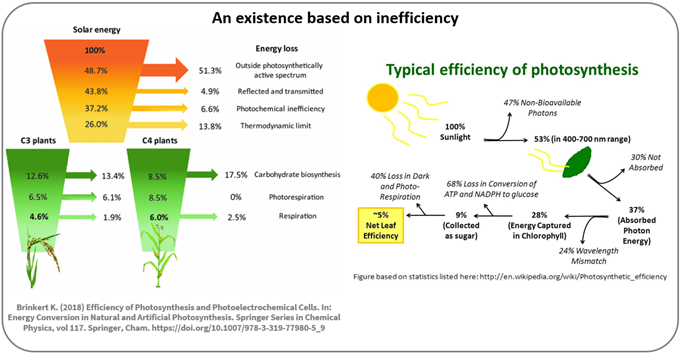
Don’t worry, be happy?
So yes, we get it. Efficiency isn’t everything. If there is lots and lots of an energy source available we don’t have to worry too much about its efficiency, because it is there for the taking. More than enough of it. In those situations, why worry?
People today often use this in a context of “renewable” energy sources, or to be more correct, renewable exergy. Useable energy that can be put to work, that is naturally replenishing on human time scales. When we look at our situation today, often we see from the intermittency and variability of weather - that things like hydroelectric, wind, and solar energy can have daily, seasonal, and weather driven variations. There are times when they are working great, and the supply inundates demand, with a surplus to requirements. Ah-hah, the argument goes, so efficiency isn’t a concern in this situation.
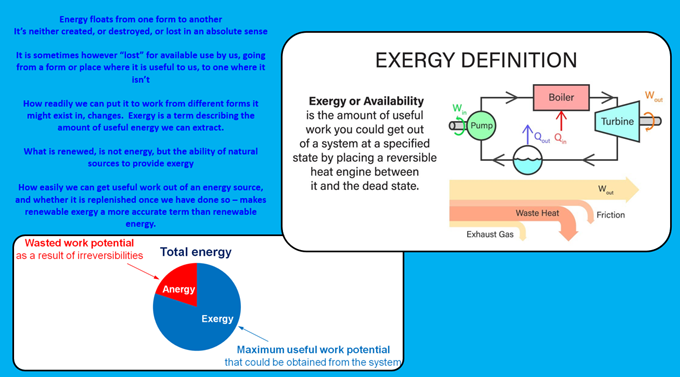
Well to an extent that is true in the here and now. If there are big surpluses happening periodically, why not put that energy to some low efficiency use at that time, since the alternative is not using it all. Any benefit, any exergy, is better than zero. If the supplier is happy, if the customer is happy, and the energy is used where it wouldn’t be otherwise, what’s not to like?
Time – now is not representative
I’m happy to accept that premise, that for now there are times and places when this is true. The picture changes a bit when we start to have a concern for the future, and planning for it as best we can. After all, most of us have a limited pot of cash, so we want to spend it in the optimal way. And maybe, if we have a community spirit, we also want to spend that money in a way that is not just best for us but has positive implications for all of the society we inhabit.
The issue is that while we might have access to lots of energy and by implication exergy, through all the avenues open to us - the proportion of it that is low-emitting and naturally replenishing over human time scales is finite. At present it is finite way below the level of our energy use. That means - however big that difference is - we need to use that low-emitting proportion as efficiently as we can.
The thing about energy efficiency is that we are at a time of important flux. The now is not representative. When we are in the middle of a huge transition - from fossil fuel dependence to an exhausting search for ways to wean ourselves off that - we cannot then look to the status quo as the basis for what is needed.
In particular the way we use renewable energy sources now is going to change. The infrastructure for optimal use of them has only just initiated. Furthermore, the demand for greater use of them has only just initiated. As more and more things look to source their energy needs from renewable exergy, so the demand for it will increase dramatically.
There are three key things in particular that impact these changes in how we will put renewable exergy to use:
- The technologies for energy storage,
- The geographic distribution of energy distribution networks, and
- The deliberate physical placement of key energy demand, next to renewable exergy supply.
Numerous new developments for energy storage are happening. Some of these are new technologies, some of them are old. It includes things like capacitors, flywheels, batteries, compressed and liquid air, superconducting magnets, pumped hydro, thermal storage in molten salts, concrete or crushed rock, underground aquifers, or storage via chemical transitions, including things like ammonia, methanol and hydrogen.
Major intermittency issues are a transient phase
All of these three options above together transform the proposition for intermittent supplies of energy. These options are not all equally available everywhere, so there is an involved look at each location required to select the best ones. Obviously though, the imperative, when we want to store energy, is to get as much out from what we put in as possible – i.e. efficiency. Why lose [in terms of utility] any more than we have to? There is the factor of cost as well – we don’t have an infinite bank balance to achieve better efficiency at any cost. Diminishing returns and all that - but all else being equal we would prefer more efficient options because we get more use. There will always be losses, but the drive to minimise them will be real.
The fact that renewable exergy has only just started to be deployed hand in hand with storage options should alert us even more to the fact that now is not representative. Changes in how much renewable exergy supply we can keep and store, means its excess is no longer something that is only available as a surplus at a particular time. It means we can also have a proportion of it later if we choose to. That means there is a greater drive to store and use it efficiently. It also means demand will go up even more than we already anticipate it will - as it becomes more deployable and useful.
Heating, power supply, vehicles. These are things which now have huge proportions of their energy source from fossil fuels. We cannot expect that to stay the same. Storage technologies empower renewable exergy to supply more of those things. So do not expect intermittency surpluses to stay the same. Do not expect power demand to stay the same. Do no expect power price to stay the same. Do not expect the grid’s current difficulties in dealing with intermittent supply to stay the same.
Distal exergy
All else being equal, proximal energy is best. Whenever we move energy distally there are energy losses to the environment it passes through. That said, distal energy transmission is getting better and better, and we are getting better at minimising energy losses. So while it is no answer to everything, there are new solutions that arise - when we can use energy that originates distally. We already know this from shipping oil and gas around the globe. However for intermittent renewables it has been less easy. Long distance electrical transmission is needed, and that infrastructure isn’t in place everywhere.
That is changing. Long distance interconnectors between countries are becoming more and more common – not just in Europe, but around the world in Africa, Latin America, and Asia. China and India as two huge nations of enormously varying geography, are particularly active. HVDC or high voltage DC lines take power most efficiently over long distances from point to point, and are big business. In the Middle East too – Saudi and Egypt are amongst the latest nations collaborating on this front there, but there is no shortage around the world. Projects of this kind are happening almost everywhere.
They aren’t some kind of magical panacea to all our energy problems, and use of energy in a particular application is always going to be more efficient done proximally than distally – but it does change the paradigm with respect to intermittent energy sources.
In any one geographic location, the time of the wind blowing or sun shining brightly is difficult to predict. But we know it is likely to be windy somewhere at any given time, and that on the daylight sides of the earth, that it will be sunny somewhere. On average these things aren’t intermittent. If we can create an energy distribution network that is big enough to see the average rather than just the point variations at one locality, then it matters, and helps. In the example of very wind dependent North Atlantic economies, an HVDC interconnector network that has the dimensions of a typical North Atlantic weather system – say 2500 km, has a lot going for it. The places in surplus share with those in deficit, and the network is big enough to ensure both are likely to be present over the area at any one time. Usually. Not always. Becalming anticyclones can sometimes be big, but the number of times that the "exergy catchment area" is active, is vastly improved.
We are not quite there yet in the UK, but those existing interconnectors to Ireland, France, Netherlands, Norway, and under construction to Denmark, are getting close to this dimension. Each of these are in turn interconnected variously to Germany, Spain, and so on, so it allows the possibility for intercontinental power-swop trades even if not direct physical transmission. Interconnectors to Iceland are also currently mooted, which would add a dramatic increase in dimension, to approach that weather system diameter criterion from UK interconnectors alone. With offshore wind on the rise technologically and commercially, to harness the regions where wind is really strongest – well, that is worth noticing.
Interconnectors to North African and Middle Eastern solar also seem only a matter of time, though of course there will be deep competition for that power from the rapidly expanding economies of the Middle East and Africa. Domestic demand and the economies of huge rapidly growing nations like Ethiopia and Nigeria will increasingly, and quite rightly, have first dibs on that power.
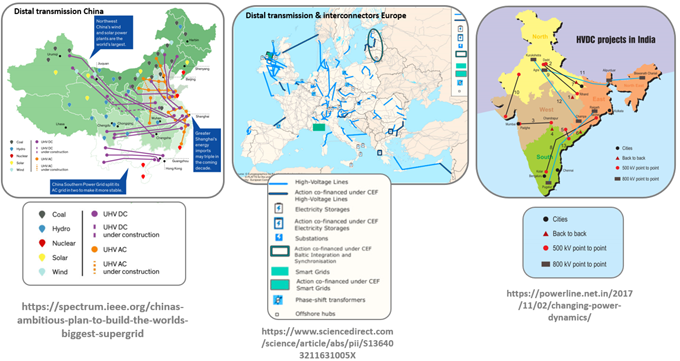
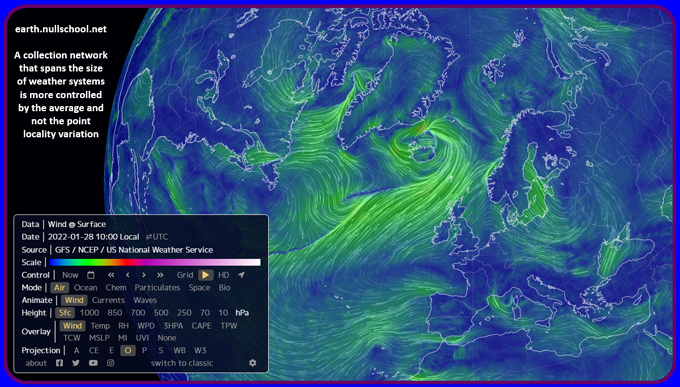
Designing for intermittency
The other obvious thing to note is that so far we simply haven’t designed our power infrastructures for intermittent sources. The experts will tell us how there are all sorts of technical issues here – it’s not as simple as plug and play. The point is though, our grids are not fit for purpose for large intermittent supplies - but - that is changing and will change even more. Again, now is not representative. Even better, given that distal transmission is not the optimal efficiency, there will be an increasing drive to build demand around renewable energy hubs, so that it can be taken advantage of when it arises - by multiple nearby users. Think various industries, think public transport electric vehicle charging hubs. The possibilities are legion and imagination in this regard is set to thrive. Power demand of the future can be built in the locations to take advantage of available renewable energy most efficiently. We simply haven’t even begun to take full advantage of these options yet.
This is not to say that renewable exergy is the answer to all our woes. Rather the opposite. With all the supply chain crunches that loom, and the changes in amounts and geographies of demand that will occur, there is going to be a demand struggle that is only just now precipitating. Look for example at the rises in lithium price over the past month. The things we build our renewable exergy machines from are getting in tighter and tighter supply. The various renewable exergy supply chains are not static, and the crunches coming will be diverse. Some more expected and predictable than others. Making the best use of renewable exergy infrastructure will become not just a desirable, but an imperative.
Beware of investment based on a transient
We see then, that these three things: 1-proactively designing and constructing for supply and demand geographies, 2-distal energy transmission, and 3-advances in energy storage – will all have vast impacts on the current renewable intermittency issues. That means in turn that it will become easier to use renewable power that does exist. That means the demand for it will rise. Does that mean the price will also rise? Who knows, we shall see. It depends on the cost of making the supply, and the level of demand - so very hard to say.
Suffice to say that assumptions of a steady decrease in the price of power should be treated with great caution. If we go from a situation where power supplies 20-25% of a nation’s primary energy (as is typical of many OECD economies now) to one where it supplies 75-80%, then price assumptions as we know them will be thrown out the window. Especially where there is a commodity crunch on the raw materials to make the exergy harvesting machines we need.
In other words, renewable power intermittency may well be a transient phenomenon. Investing on the basis that it will stay the way it is now, is making an assumption that is very shaky.
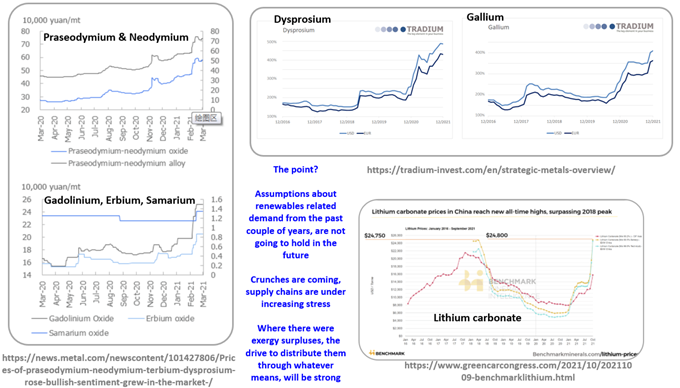
The implications for efficiency
What this means, very simply, is that where there are surpluses in renewably sourced exergy now, they may not be long lived. Power demand will go up, and the frequency of surplus situations will go down. That means, there will be an increasing imperative with time, to make the best use of what renewable exergy there is. That in turn means there will be an increasing drive to use it most efficiently. Especially in the context of energy storage. As these issues become increasingly acute, governments will most likely want to become more involved in managing the best use of renewable exergy. Much more so than they are now.
For now it may be enough that a supplier and customer are happy, but be warned, as the demand for renewable exergy increases, regulators are going to be ever more invested in ensuring the optimal use of its supply to as many customers as possible.
Plan and invest accordingly – neglect efficiency at your peril.
For now the efficiency police might seem like an annoying social media presence raining on the parades of renewable energy surpluses. Take note however, that as things evolve, the efficiency police may morph into something far more official with far more legal and regulatory clout than is currently the case.
There may be a window of opportunity over the next decade or so, maybe a bit longer, when it frequently doesn’t matter so much (at least from a medium term investment perspective). My money, however, is that after that time, it will matter, far more. The forthcoming crunches on renewable exergy demand haven’t even begun. Such crunches will become the domain of an efficiency police force far more vigorous than anything that exists now.
KeyFacts Energy Industry Directory: Paetoro Consulting
 KEYFACT Energy
KEYFACT Energy